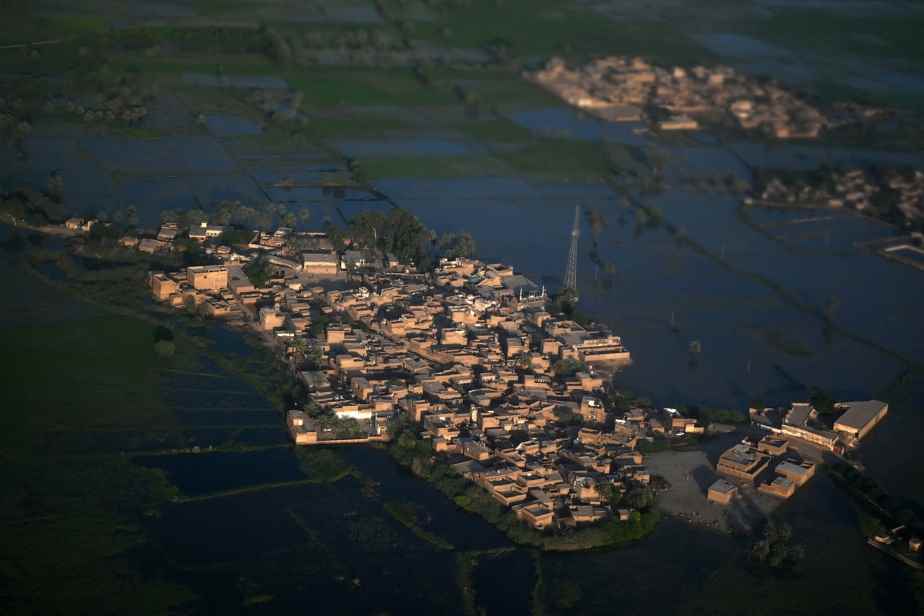(Mehar) From a hastily erected seawall to protect the town of Mehar, in southern Pakistan, only the top of the minarets of a mosque and the top of a petrol station emerge from a vast lake created by the floods over tens of kilometers long.
Posted at 12:18 a.m.
Beyond that, hundreds of villages and huge swaths of farmland have disappeared under water after floods triggered by torrential monsoon rains since June submerged a third of the country.
“No one knows where their village is anymore. The man in the street can no longer recognize his own house”, remarks Ayaz Ali, whose village, in this province of Sindh, is under almost seven meters of water.
The provincial government estimates that more than 100,000 people have been displaced by this new body of water, born of record rains and flooding in some places of the great Indus river nearby.
Across the country, more than 33 million people have been affected by the floods, nearly two million homes and businesses destroyed, 7,000 km of roads washed away and 256 bridges destroyed.
A bus driver by profession, Ayaz guides Pakistan Navy volunteers, who navigate these waters in two rubber dinghies, delivering food to locals or ferrying people in need of care to town.
Thanks to his excellent memory, Ayaz is able to identify submerged villages just by the geography of electricity pylons or the outline of treetops.
With his help, the soldiers search the rare bits of land that have remained emerged, where some families are sheltering, who refuse to be evacuated even though their situation is getting worse with the oppressive heat.

PHOTO AKHTAR SOOMRO, REUTERS
The flooded town of Larkanan in Pakistan on Saturday
“How could we leave? »
“Their home and their belongings are so precious to them,” says a soldier, who requests anonymity, looking at the huge expanse of water that surrounds him.
“When I joined the Navy, I never imagined doing something like this,” he admits.
With the engine off, the boat moves slowly through the treetops, and you even have to lower your head to pass under power lines as you approach a small group of half-collapsed houses surrounded by water.
Dozens of people are waiting there. Many also continue to refuse to leave, worried that their livestock – their last wealth – will die or be stolen in their absence, or fearing life in the camps for displaced people that have sprung up all over the country.
“Our life and our death are linked to our village. How could we leave? asks Aseer Ali, knee deep in water and refusing to let his wife go, despite being eight months pregnant.
Others eventually give in — feverish men, young children with diarrhoea, an elderly woman wallowing in fearful silence — and get on the canoe, which now takes twice as many people to town as it does. is supposed to.
Among them is a young mother who suffered the immense pain of losing her newborn baby when the waters rose around her house last week.

PHOTO AKHTAR SOOMRO, REUTERS
Flooded land in Sukkur, Pakistan, Saturday
“Gone to protect the city”
She staggers as if under the effect of sunstroke, her two-year-old child at her side also suffering in the midday sun. A soldier tries to relieve them by spraying them copiously with water.
The new mud dyke, 10 km long, has so far prevented the lake from expanding and submerging the town of Mehar, which is home to several hundred thousand people.
Many displaced people have arrived in the city over the past three weeks, settling in makeshift camps created in parking lots, in schools or on highways.
“More and more families are arriving at the camp. They are in a horrible state”, observes Muhammad Iqbal, of the Alkhidmat Foundation, a Pakistani humanitarian organization which is the only one present in the largest camp in the city, which hosts around 400 people.
“There is a huge need for drinking water and toilets,” he explains. But the displaced may still have to wait, as the government’s priority is to drain water from flooded areas.
Water pressure has increased on dams and reservoirs ready to overflow, forcing authorities to dig diversion canals to save densely populated places, sometimes at the expense of rural areas.
“They all went to protect the city, but not the rural poor,” said Umaida Solangi, a 30-year-old woman resting with her children on a bed of braided ropes in a camp.
